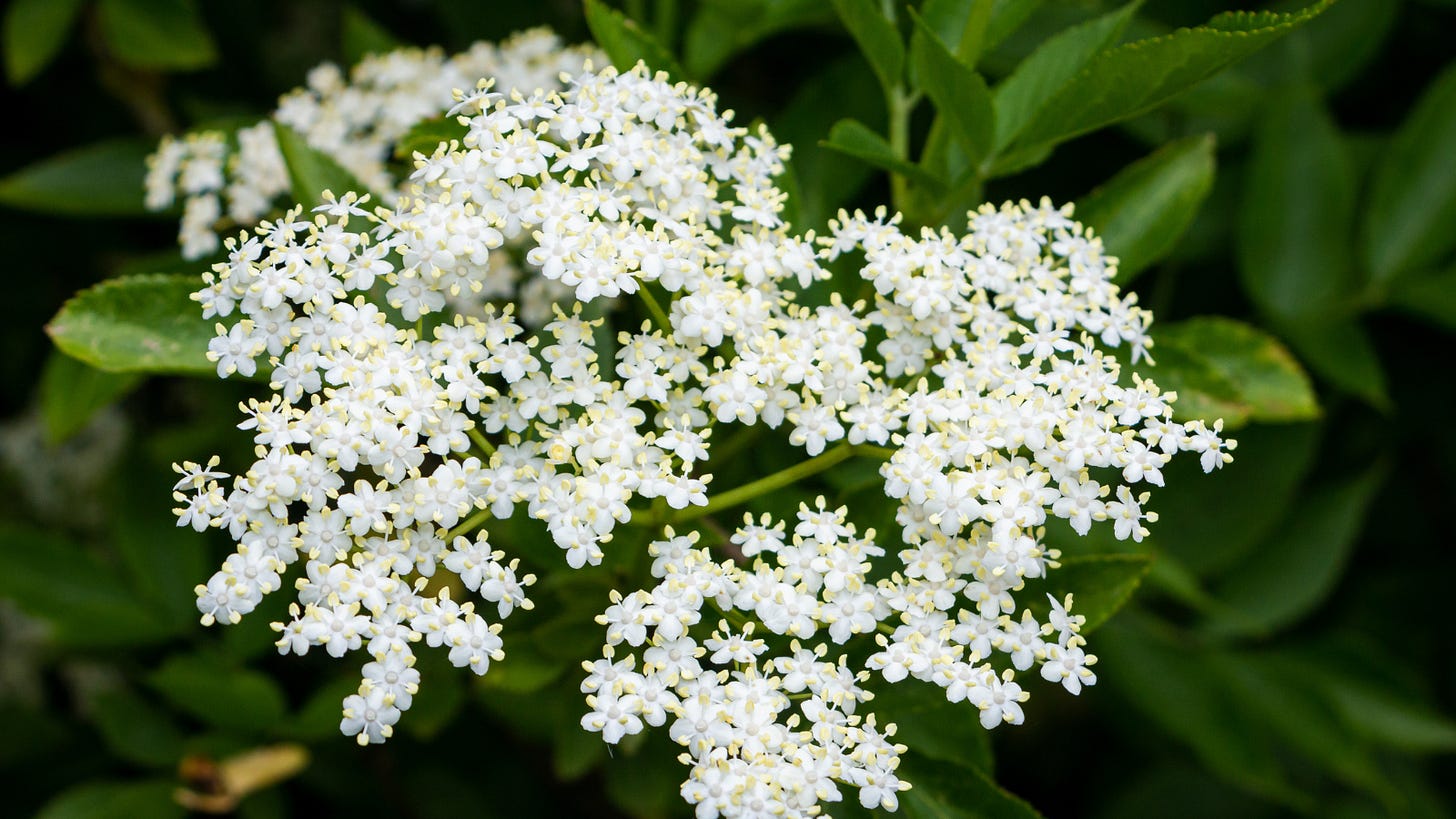Elderflowers
While elderberry fruit extracts are a popular supplement ingredient, there is much to love about elderflowers as well!
It’s that time of year when the lovely white bunches of elderberry flowers decorate the countryside of Europe. The black elder tree (elderberry), also known by its scientific name of Sambucus nigra L. of the Viburnaceae family. One of my favorite natural soda treats is elderflower soda. Oftentimes, you can find this in restaurants in Europe made with from a syrup of the flowers, mixed with sparkling water, and sometimes garnished with mint, lemon balm, and a slice of lemon. [Here’s a recipe for elderflower syrup plus other preparations]. Sometimes, you can find the refreshing elder flower soda made as a natural sparkling fermented beverage. [Here’s a recipe for the natural ferment.]
While there are many edible flowers to be found in the Mediterranean basin, for example, one study (Edible Flowers Used in Some Countries of the Mediterranean Basin: An Ethnobotanical Overview) found that elderflowers are the most popular. In addition to their use in beverages, the scented inflorescence of this plant (grouped in large corymbs) are also prepared in batter and fried.
Traditional Medicinal Uses
Elder flowers have a long history of use in traditional medicine across regions such as Albania, Algeria, Italy, and Spain. Taken internally, they are commonly used to treat bronchial conditions, colds, and abdominal discomfort, and are valued for their anti-inflammatory, antipyretic, diuretic, digestive, diaphoretic, anti-rheumatic, and galactagogue properties. Topically, elder flowers are traditionally applied to soothe conjunctivitis, heal wounds and burns, and relieve rheumatic pain. Infusions made from the flowers are also used as natural skin toners and brighteners.
Chemical Composition of Elderflowers
Elderflowers are rich in a diverse array of bioactive compounds that contribute to their medicinal properties. They contain approximately 3.0% flavonoids, including kaempferol, quercetin, rutin, astragalin, isoquercitrin, hyperoside, and nicotiflorin, which are known for their antioxidant and anti-inflammatory effects. Phenolic acids and their glycosides also make up about 3.0% of the composition, with notable compounds such as chlorogenic acid, various caffeoylquinic acid isomers, p-coumaric acid, and ferulic acid—many of which play roles in modulating inflammation and oxidative stress. In addition, elderflowers contain around 1.0% triterpenes, including α- and β-amyrin, ursolic acid, oleanolic acid, and benzoic acid, which are associated with anti-inflammatory and antimicrobial activities. The flowers also provide approximately 1.0% sterols, such as β-sitosterol, campesterol, stigmasterol, and cholesterol, which may support skin health and modulate immune responses.
Anti-inflammatory Properties of Elderflower
This study on inflammation (Sambucus nigra: A traditional medicine effective in reducing inflammation in mice) highlights the powerful anti-inflammatory effects of elderflower extract. In a mouse model of inflammation, oral doses of the extract reduced neutrophil migration and significantly lowered levels of pro-inflammatory cytokines like TNF, IL-1β, and IL-6. In lab studies, immune cells treated with the extract also showed reduced production of inflammatory markers and an increase in IL-10, an anti-inflammatory cytokine. These benefits are largely attributed to rutin, a major compound in elderflowers.
A Note on Safety
Whether you enjoy elderflowers for their delightful flavor or their medicinal benefits, proper preparation is essential to ensure safety. The plant contains cyanogenic glycosides—compounds that include a cyanide group attached to a sugar molecule. One such compound, sambunigrin, is also present in the seeds of fruits like apples and peaches. When consumed, the cyanide group can be released during digestion, posing potential toxic effects in high amounts. These compounds are most concentrated in the stems, leaves, and unripe berries of the plant.
To safely enjoy elderflower preparations, it's important to remove all stems before using the flowers in syrups, teas, or ferments. Traditional methods typically involve harvesting only the fully open blossoms and gently trimming off the green parts before drying or infusing them. This not only reduces toxicity risk but also enhances the flavor and quality of the final product. Also, cooking the flowers, such as when making a syrup, breaks down the cyanogenic glycosides and sambucine.
The Takeaway
Elderflower sodas are a special treat to enjoy in the early days of summer. I hope you’ll have a chance to give it a try!
Yours in health, Dr. Quave
Cassandra L. Quave, Ph.D. is a Guggenheim Fellow, CNN Champion for Change, Fellow of the National Academy of Inventors, recipient of The National Academies Award for Excellence in Science Communication, and award-winning author of The Plant Hunter. Her day job is as professor and herbarium director at Emory University School of Medicine, where she leads a group of research scientists studying medicinal plants to find new life-saving drugs from nature. She hosts the Foodie Pharmacology podcast and writes the Nature’s Pharmacy newsletter to share the science behind natural medicines. To support her effort, consider a paid or founding subscription to Nature’s Pharmacy or donation to her lab research.
The Plant Hunter is available in hardcover, paperback, audio, and e-book formats!







Thanks so much for the mention! Totally made my day 🌿✨ Elderflower-powered gratitude from this chaotic seasonal soul – Lela